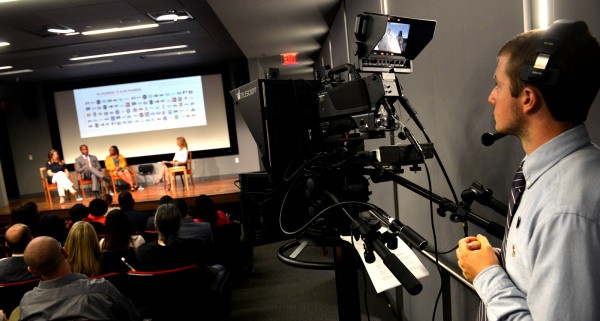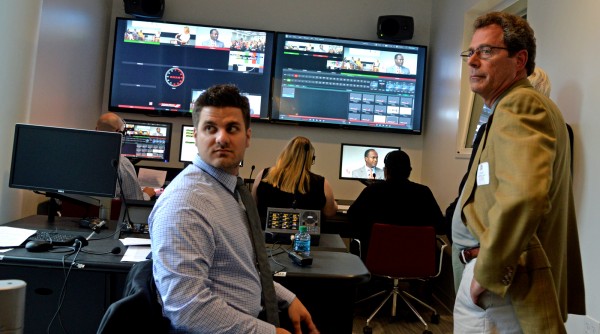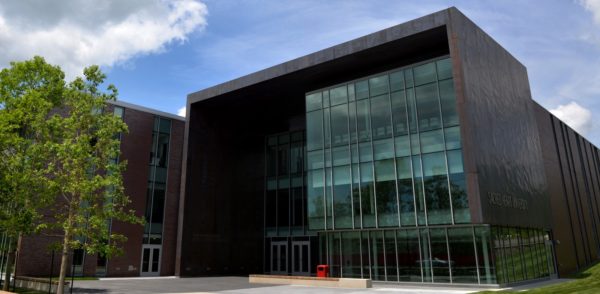Connecticut has drawn media companies big and small to the state, and now educators are training a workforce.
“We”™re there to help create that pipeline from the institutes of higher learning to these employers,” said George Norfleet, director of the state Department of Economic and Community Development”™s Office of Film, Television and Digital Media.
The state partnered with the University of Connecticut to offer the first Digital Media CT training program this summer at its Stamford campus, and Sacred Heart University opened the Frank and Marisa Martire Business and Communications Center, with state-of-the art production equipment, in March. Fairfield County businesses and universities are working together to ensure students high school aged and older and learning skills to make them hirable.

- Master”™s degree student Sean Elliott films a panel discussion in June in the Martire Business and Communications Center at Sacred Heart University. Photo by Tracy Deer-Mirek
In 2006, the state established a program to offer up to a 30 percent tax credit to digital and motion picture companies and has offered other incentives to recruit companies to Connecticut. Examples include Blue Sky Studios, an animation company that moved from White Plains to Greenwich in 2008, and NBC Sports Group, which consolidated into a new Stamford facility in 2013.
In the past nine years, companies in the film, television and digital media industries have spent more than $1.5 billion in the state and Connecticut has given more than $400 million in tax credits, Norfleet said.
Newly arrived companies along with longtime businesses like World Wrestling Entertainment in Stamford and ESPN in Bristol, which last year completed its 194,000-square-foot digital center, create their own jobs and outsource work to the approximately 700 smaller digital media firms, he said. The total number of resident employees in the digital media industry has grown 17 percent in the past 10 years and is expected to climb 22 percent in the next eight years, Norfleet said.
Yet these companies, along with other types of businesses that have growing technical needs, have a hard time finding employees with skills to fill open positions, Norfleet said. The program at UConn, a monthlong intensive course, was a response to this problem.
“We wanted to make sure we were preparing Connecticut residents to participate by getting jobs in this sector, so we wanted to make sure the training was available,” Norfleet said.
The state invested in the equipment for the program. Professors from the main campus in Storrs taught classes in four tracks, including 3-D animation in Cinema 4D, game design, motion graphics design and Web design. The program cost $500 per course, and students received a certificate upon completion.
Twenty-five people from different backgrounds participated this summer; some were high school students, college students, business owners and veterans. Professionals from local media companies spoke at the classes, providing students the opportunity to make connections and potentially get a job or an internship, Norfleet said.
The program will be offered next summer, and the university is determining whether the program will take place during the school year.

- Student Tom Naclerio and Professor Joe Alicastro work in one of the Martire Business and Communications Center”™s control rooms. Photo by Tracy Deer-Mirek
Companies like NBC and smaller firms and shops provide the opportunity for Sacred Heart University students to have internships and use their digital skills, said James Castonguay, a communication and media studies professor at the university in Fairfield.
Undergraduate and graduate students in the Department of Communications and Media Studies learn how to integrate all aspects of digital media production into storytelling, whether they are learning how to be a “backpack journalist” or a corporate public relations professional, he said.
The new Martire building, which houses the John F. Welch College of Business and the communications department, has two full-size television studios, two control rooms, two media labs, two screening rooms and a radio station. Its motion capture lab enables communication, computer science and theater students to collaborate, Castonguay said.
David Taylor, a marketing professor at SHU, said the building will allow business and communication students to work together and learn about both areas, which is needed in the digital marketing and digital media industries.
Taylor said he was surprised that many of the students in the schools”™ digital marketing graduate programs, one of the only of its kind in the country, are working adults learning skills to bring back to their jobs.
His students have created digital marketing plans for 1-800-Flowers, PepsiCo, Kodak and nonprofits as part of their coursework.
“That just shows you that companies now are faced with the task of going through universities and having us help them with their strategy because they don”™t have those skills,” Taylor said.
He also works with high school students in collaboration with Starwood Hotels & Resorts Worldwide and the Mayor”™s Youth Employment Program in Stamford on a summer internship program for Stamford high school students. The program involves on-the-job work and classroom training with Sacred Heart professors.
Michelle Naggar, vice president, social responsibility at Starwood, said the program idea started in 2012 when the company was evaluating a human resources issue.
Starwood Hotels employs 1,200 people in Stamford, many of whom are in the company”™s technology group, Naggar said. The company often loses candidates to similar jobs in New York City and ends up hiring from out of state or out of the country.
“It”™s an ongoing struggle,” she said. “I know Starwood”™s not the only company that”™s struggled in this space.”
The company and the university also worked together to evolve the marketing program in Stamford public high schools to make it more digitally focused. She said the company wants to foster students”™ interest in digital marketing before college, with the hope that they will return to work in the area.
Castonguay said with companies like NBC Sports and NBCUniversal, there are more jobs now than even four years ago for his students.
“Right now, Connecticut”™s a really good place to be,” he said.
This article has been updated to reflect that in the past nine years, Connecticut has given more than $400 million in tax credits to companies in the film, television and digital media industries. An earlier version incorrectly stated that amount.





















